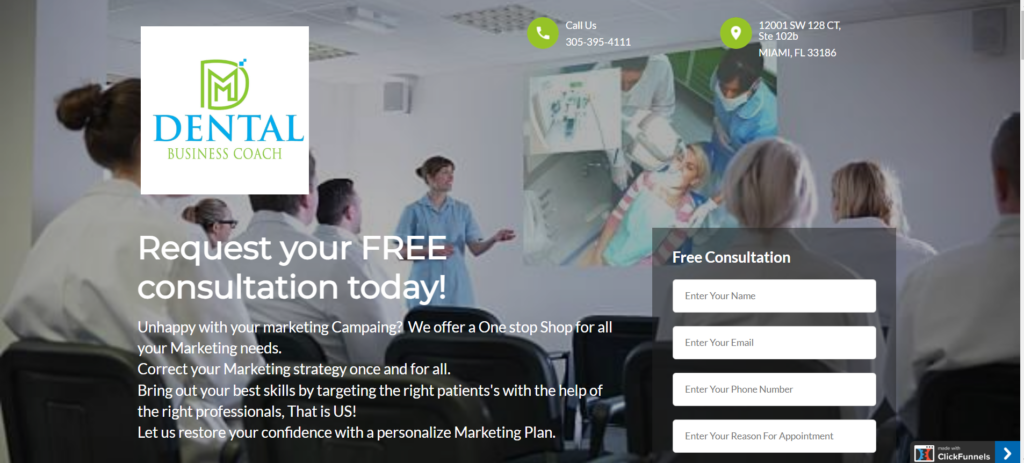Introduction
Imagine a potential patient, perhaps new to the area or dissatisfied with their current dentist. Where do they turn? Not to a phonebook, but to their smartphone or computer. In seconds, they’re face-to-face with your practice—or at least, its digital representation.
This is where the art and science of dentist website design come into play. It’s not just about having a website; it’s about crafting an online experience that captures the essence of your practice. Your site needs to be more than a mere digital brochure. It should be a warm, inviting space that puts patients at ease, much like your physical office.
But how do you achieve this delicate balance? Let’s dive into the world of dentist website design and explore how to create a site that truly shines.
Table of Contents
Crucial Role of Dentist Website Design in Practice Success
Why does your dental practice need a stellar online presence? Simple: it’s your digital storefront. Your website is often the first impression potential patients have of your practice. A professional, user-friendly site can be the deciding factor in choosing your services.
The impact of website design on patient acquisition and retention can’t be overstated. A well-designed site not only attracts new patients but also keeps existing ones engaged. It’s a powerful tool for building trust and showcasing your expertise.

First Impressions: The Psychology Behind Dental Website Design
One-Second Rule in Dental Web Design
Did you know visitors form an opinion about your website in less than a second? That’s right, you have a split second to make a good impression. This is where the best dental website design practices come into play.
What makes an immediate positive impact? Clean layouts, professional imagery, and clear messaging are key. Your homepage should instantly convey who you are and what you offer.
User Experience (UX) in Dental Websites
In crafting dental practice websites, prioritizing user experience is essential. A well-designed, easy-to-navigate site helps retain visitors’ interest. Key information like services offered and contact information should be readily accessible.
The design’s intuitiveness plays a significant role in minimizing bounce rates. Research conducted by Google indicates that over half of mobile users abandon websites that don’t load within three seconds. Therefore, a dental office’s online presence must emphasize both swift loading times and user-friendly design.
Building Trust and Professionalism Through Design
Visual cues can convey expertise and reliability. High-quality images of your practice and team, coupled with a clean design, build trust. But it’s a balancing act. Your site should be professional yet approachable.
Remember, patients are looking for a dentist they can trust. Your website design should reflect the care and attention you give to your patients.
Essential Features of an Effective Dentist Website Design
Showcasing Crucial Practice Information
Your contact details and credentials should be front and center. A dental website designer worth their salt will ensure this information is easily accessible from any page.
Integrating Google Maps is a must. It helps potential patients find your location easily, improving their overall experience.
Creating Compelling Service Pages
When it comes to dental practice website design, service pages are crucial. They should clearly outline what you offer and why patients should choose you. Use clear, jargon-free language to explain procedures.
Visuals can be powerful in explaining complex procedures. Consider using infographics or short videos to break down treatments. This not only informs but also puts patients at ease.
“Meet the Team” Section: Humanizing Your Practice
A well-designed “Meet the Team” section can set you apart. It puts a face to your practice, making it more approachable. Consider adding short bios and professional photos of your staff.
Interactive elements can make this section more engaging. Perhaps a short video introduction or clickable bios for more information. This personal touch can make a big difference.
Crafting an Engaging FAQ Section
An FAQ section can save you and your patients time. Design it with user-friendliness in mind. Group questions by topic for easy navigation.
Consider adding a search function to your FAQ. This allows patients to quickly find answers to their specific questions. It’s all about making information accessible.
Streamlining Online Appointment Scheduling
Online appointment scheduling is a must-have feature. It should be easy to find and use. A dental website design company can help integrate this seamlessly into your site.
Make sure your appointment forms are mobile-friendly. Many patients will be accessing your site on their phones. The easier it is to book, the more likely they are to do so.
Leveraging Patient Testimonials and Reviews
Patient testimonials can be powerful social proof. Display them prominently, but ensure they look authentic. Video testimonials can be particularly effective.
Integrating third-party review platforms can add credibility. It shows you’re transparent and confident in your service. Just ensure the integration doesn’t slow down your site.

Educational Content: Positioning Your Practice as an Authority
A blog or resource center can position you as an authority in dental care. Design it to be easily navigable and visually appealing. Regular updates can also boost your SEO.
Consider incorporating various types of content. Articles, videos, and infographics can cater to different learning styles. This diversity can keep patients engaged and coming back for more.
Advanced Design Considerations for Dental Websites
Color Psychology in Dentist Website Design
Colors can evoke emotions and set the tone for your site. Blues and greens often work well for dental websites, conveying trust and calmness. But don’t be afraid to inject some personality with accent colors.
Use color strategically to create visual hierarchies. This can guide users’ attention to important elements like your contact information or appointment booking button.

Typography and Readability for Dental Websites
Your choice of fonts can reflect your practice’s personality. However, readability should always be the priority. Sans-serif fonts often work well for body text on screens.
Ensure your text is legible across all devices and for all age groups. This might mean larger font sizes and high contrast between text and background.
Implementing Effective Calls-to-Action (CTAs)
Well-designed CTAs can significantly increase conversions. They should stand out visually and use action-oriented language. “Book Your Appointment Now” is more effective than “Click Here”.
A/B testing can help optimize your CTAs. Try different colors, sizes, and placements to see what works best. Small changes can lead to big improvements in click-through rates.
Accessibility in Dental Web Design
Making your website accessible isn’t merely a nice-to-have feature; it’s a necessity. The site should cater to all possible patients, including those with various disabilities. This involves implementing features such as alternative text for images and ensuring the site can be navigated using only a keyboard.
It’s vital to adhere to the Web Content Accessibility Guidelines (WCAG). Doing so not only broadens your site’s reach to a more diverse audience but can also boost your search engine optimization efforts.
Technical Aspects of Dentist Website Design
Mobile Optimization Techniques
In today’s mobile-first world, responsive design is non-negotiable. Your site should look and function well on all devices, from smartphones to desktops.
Consider a mobile-first approach in your dentist website design. This means designing for mobile devices first, then scaling up for larger screens. It ensures a smooth experience for the majority of users.
Page Speed Optimization for Dental Websites
Page speed is crucial for user experience and SEO. Techniques like image optimization and minifying code can help speed up your site. Remember, every second counts.
Balancing visual appeal with performance can be tricky. High-quality images are important, but they shouldn’t slow down your site. Compression and lazy loading can help strike this balance.
SEO Best Practices in Dental Web Design
On-page dental SEO elements are crucial for visibility. This includes optimizing title tags, meta descriptions, and header tags. Use relevant keywords naturally throughout your content.
Local SEO is particularly important for dental practices. Ensure your NAP (Name, Address, Phone) information is consistent across your site and online directories. This helps Google understand and rank your business for local searches.
Compliance and Security in Dentist Website Design
HIPAA Compliance in Dental Web Design
When it comes to managing patient data, strict adherence to HIPAA regulations is an absolute must. Any online forms or patient access portals must be designed with robust security measures and full compliance in mind. Partnering with a web design firm that specializes in healthcare can be invaluable in navigating the complex landscape of these regulatory requirements.
It’s crucial to make your website’s privacy policy and terms of service easily findable for visitors. These documents should provide a clear and straightforward explanation of your patient data handling practices. By being open and transparent about these matters, you can foster a sense of trust and reliability with your potential patients.
SSL Certificates and Data Protection
HTTPS is a must for dental websites. It encrypts data transmission, protecting sensitive information. It also builds trust with patients and is a ranking factor for Google.
Communicate your security measures to patients. A visible security badge or a brief explanation can reassure visitors that their information is safe with you.
Common Pitfalls in Dentist Website Design
Avoid overcomplicating your navigation. Keep it simple and intuitive. Users should find what they need in three clicks or less.
Regular content updates are crucial. An outdated website can make patients question the quality of your practice. Set a schedule for reviewing and updating your content.
Don’t ignore your website analytics. They provide valuable insights into user behavior. Use this data to continually improve your site’s performance and user experience.

Future Trends in Dental Website Design
AI-powered chatbots are becoming increasingly popular. They can handle basic inquiries 24/7, improving patient service and freeing up your staff’s time.
Virtual reality tours could be the next big thing in dental website design. They allow potential patients to explore your practice from the comfort of their homes.
Personalized content experiences are on the rise. Returning visitors might see content tailored to their interests or previous interactions with your site.
Conclusion: Elevating Your Practice Through Expert Dentist Website Design
A well-designed website is a powerful tool for your dental practice. It can attract new patients, retain existing ones, and showcase your expertise. Remember, your website is often the first impression potential patients have of your practice. Make it count.
Ready to elevate your online presence? Consider working with a professional dental website design company. They can help you create a site that not only looks great but also performs well and converts visitors into patients.
How much does dental website design cost?
Dental website design cost can vary widely, typically ranging from $2,000 to $10,000+. Factors include design complexity, features, and ongoing maintenance needs.
What are the must-have features for a dental website?
Essential features include clear contact information, service descriptions, online appointment booking, patient testimonials, and a mobile-responsive design.
How often should a dental website be updated?
Regular updates are crucial. Aim to review content monthly, update design elements annually, and consider a full redesign every 2-3 years to stay current.
Can I design my dental website myself?
While possible, professional dental website designers bring expertise in design, UX, and dental industry specifics that can significantly enhance your site’s effectiveness.